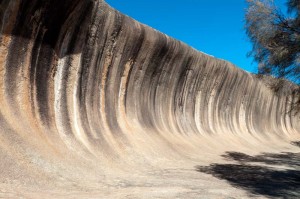Or first stop this morning was to photograph the “Catastrophic” fire sign. We’ve seen these all over Australia, and have been amused at the fire category even higher than “extreme”. This is the first one we’ve actually seen set at catastrophic, and we’re not sure if it was true, or if someone had just set it there. It doesn’t really seem all that dry here right now.
We stopped at “Wave Rock” this morning, the most famous of the granite rocks in the South Western Australian wheatbelt. It has been developed into a tourist park with a $7 admission fee per vehicle, but the rock has been left pretty much untouched from the mid 1920’s when they built a catchment wall around the top which filled a dam used for drinking water. The dam is still in use, but only as a backup supply for Hyden.
The rock itself definitely looks like a huge wave. We walked across the top of it and you get good views out in all directions to the surrounding farm stubble fields. It is hard for us to see how they can grow anything here, the land looks so poor, infertile, dry and saline, but they do seem to raise a lot of grain. We finished up the walk at Wave Rock by walking to “Hippos Yawn” which is a large eroded rock that looks like the gaping mouth of a hippo.
After that we drove to another large rock called “The Humps”. Here there is a cave called “Mulka’s Cave” with a large collection of aboriginal rock art hand prints painted on the ceiling. The cave is part of an aboriginal legend. After looking at the cave painting we walked to the top of the rock, at 100 metres high quite a bit higher than the Wave Rock. It too is eroded into some rather interesting shapes, though not as spectacular a wave form.
The rocks are very similar to those we saw several weeks ago in South Australia. While the ones we saw today are bigger, and probably more famous, all of them are eroded granite, and they’ve all been used to capture rainwater, the scarcest resource in this very dry part of Australia.
After leaving the rocks we drove southeast to Hopetoun (yes, that is the correct spelling!) where we are in the caravan park right along the beach. We walked a couple of kilometres on the beach tonight after we arrived. It would be a nice beach for swimming, but we were too tired tonight.


